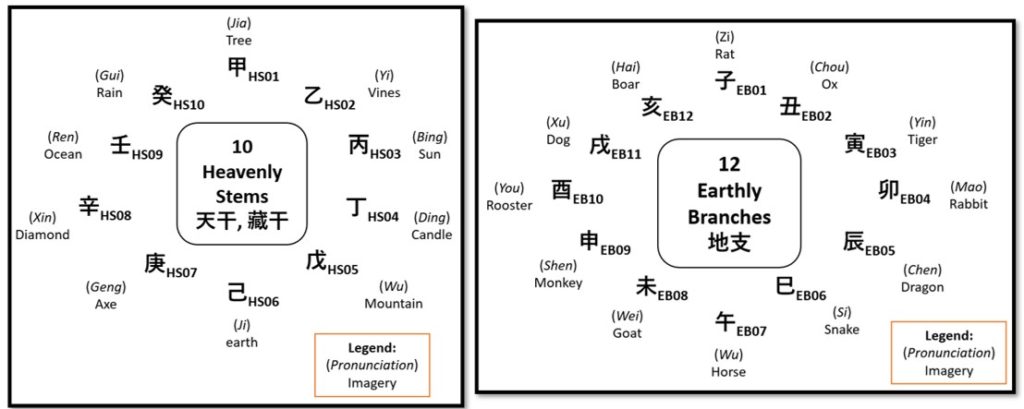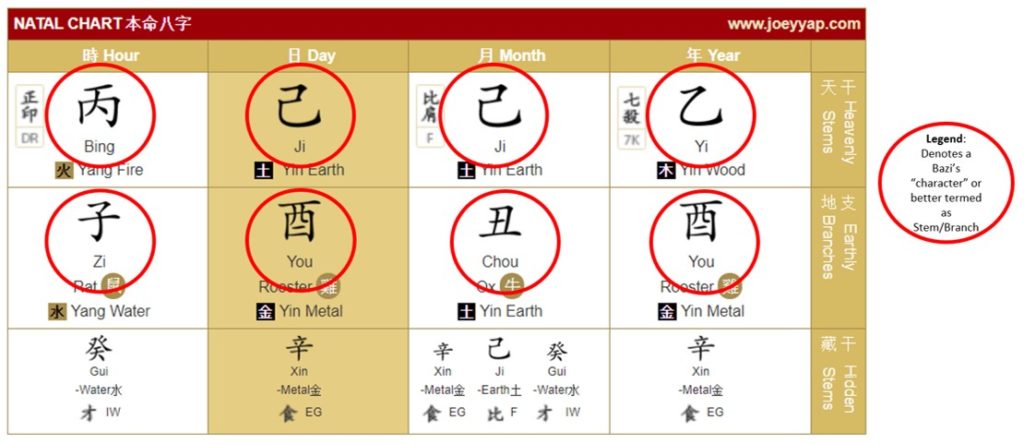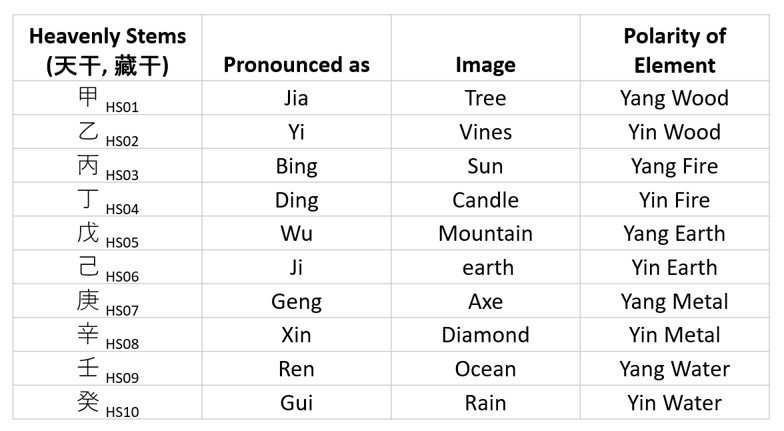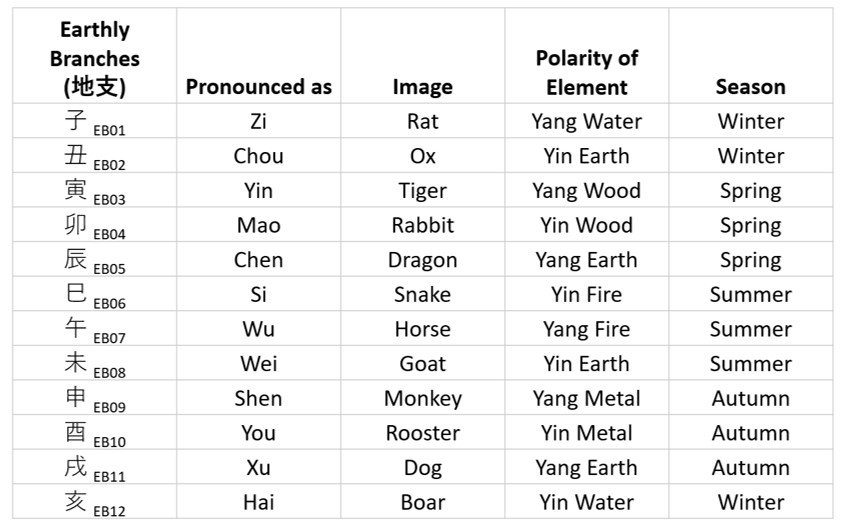Before I introduce you to some concepts of the natal chart or Bazi destiny chart….
To get this unique natal chart, you need to:
Step 1: Log in to https://bazibz.masteryacademy.com/
Step 2: Enter your details.
If you do not know the time of birth, check the “Time of Birth Unknown”.
Step 3: Save the comprehensive datasheet
And Now, you are ready to begin.
To help you understand the fundamentals of the Bazi, I will be using an example natal chart to explain and illustrate the basics. Please refer to your personal chart for reference.
There are five main components in the natal chart:
(1) Pillars
Like how the Chinese writes or reads traditionally, we read the natal chart from its Right to Left:
Everyone’s natal chart has four main columns:
- Year (年 nian)
- Month (月 yue)
- Day (日 ri), and
- Hour (时 shi)
These columns are called pillars. A pillar is also known as a Sexagenary cycle, consisting of a-Stem-and-a-Branch or 干支 (ganzhi).

(2) Heavenly Stems (or stems) and Earthly Branches (or branches)
What are the stems and branches?
You can think about stems and branches as the building blocks of the tool Bazi. For example, we have 26 alphabets in the English language, which can be arranged to make up many combinations of words. Similarly, the building blocks of Bazi are the 10 Heavenly Stems (天干 and 藏干), and the 12 Earthly Branches (地支).
Only four Heavenly Stems (or stems) and four Earthly Branches (or branches) form the basic “eight characters” (八字 Bazi) in a natal chart or Bazi destiny chart. [The basic “eight characters” (八字 Bazi) will be explained in the 3rd session of the article.]
One stem is paired with one branch of the same polarity (yin stem with yin branch, or yang stem with yang branch) to form a structure known as a Pillar or Sexagenary cycle or 干支 (ganzhi), as we learnt previously. [The yin-yang polarity of the Stems and Branches will be explained in the 5th session of the article.]
Lastly, the stems and branches have their own specific place and do not appear anywhere else in the natal chart.

Each of the 10 Heavenly Stems and each of 12 Earthly Branches are known to be a “character” or 字 (zi) or in literal translation to English – a word. Each “character” gives rise to an imagery such as 甲 (Jia) is perceived as a Tall Tree and the 子 (Zi) symbolises a Rat.
It is important to note that it is the characteristics that we are extracting from the imagery (to explain the meaning behind each “character”). For example, 甲 (Jia or a Tall Tree) portrays a character of being firm, steady and always growing, while 子 (Zi or Rat) portrays a nature that is in constant motion and enjoys freedom.
(3)
The content “Eight characters” (the content 八字 Bazi)
In the Chinese (mandarin) language, a word or a chinese character is called a “字” (zi). Each chart has 8 chinese characters. Therefore, in its most literal translation of this technique, it revolves around the “eight characters” (the content 八字 Bazi), and only contains four Heavenly Stems and four Earthly Branches.

(4) Five-element 五行 (wu xing) concept
In Chinese philosophy, its principles revolve around the five-element concept (五行): Wood 木, Fire 火, Earth 土, Metal 金 and Water 水. This concept of five-element is used to describe interactions and relationships of phenomena on Earth. They are also used to represent the different aspects in life. I will be elaborating this concept in-depth in my subsequent article posts.
(5) Yin-Yang (阴-阳) polarity
One of the basic concepts that the Chinese Metaphysics commonly uses is the Yin-Yang polarity concept. Each stem, each branch contains a polarity (Yin or Yang) and is illustrated below.


Fret not, the Yin-Yang polarity in your natal chart is already stated in the comprehensive data sheet presented from https://bazibz.masteryacademy.com/ – highlighted below.

Summary:
You must now be wondering, where do I begin to interpret the chart? How does a practitioner do it?
Answer: You may start with the Yin-Yang (阴-阳) polarity concept.
For a start, the number of Yin and Yang polarity of the “eight characters” is put into consideration. By looking at the numbers of Yin or Yang “character”, we can tell which polarity is more prominent to determine the nature of a person.

(a) Yang Nature:
If the chart has more Yang characters, it means that this person is of Yang nature. It generally represents an active person with a “Do-er” or an executor mindset. The person has a vibrant nature and shares his/her thoughts. The person may also find happiness in contributing to the society or community.
(b) Yin Nature:
If the chart has more Yin characters, it means that this person is of Yin nature. It generally represents a passive/quiet person whom often internalise matters like a strategist. Unless provoked, this person is generally reserved. The person will find true meaning in life through the journey of self-discovery.
This Yin-Yang nature best describes a person’s comfort zone or resting state. However, please take note that if even it is the person’s inherent nature, a person is also shaped by his character (being built over many years) and personality (honed from the external influences and environment) (1,2,3).
If you are into self-discovery (like myself), or have a young child or want to understand more about someone, you may be asking, “so, where do I start reading? How do I hone my child’s talents? Or how do I communicate better with my significant other?”
The answer lies in knowledge you will soon acquire and the next activity/action that you undertake. With awareness, you can focus on the areas (Friends/career/spouse/self/hobbies, etc) that impact you or someone the most in life.
Stay tuned for more in-depth concepts!
References:
- Lickerman, A. (2011). Personality vs. Character. Happiness in this World. Retrieved from https://www.psychologytoday.com/us/blog/happiness-in-world/201104/personality-vs-character
- Exeter, U. o. (2013). Personality is the result of nurture, not nature, suggests study on birds. Retrieved from https://www.sciencedaily.com/releases/2013/06/130605090524.htm
- Khan, H. I. The Sufi Message of Hazrat Inayat Khan: Philosophy, Psychology and Myst (Vol. Chapter XVII NATURE AND CHARACTER).
Disclaimer:
This article is published on nourishingthelifemap.com, a non-profitable website for anyone seeking inspiration to improve one’s perception towards life.
The information in the page or blog is meant to supplement and not substitute any proper Chinese metaphysics training. Illustrations are provided only as an aid for better understanding of contents. Readers are urged to consult a certified consultant for proper diagnosis of issues they may encounter. To maintain anonymity and confidentiality, any past events, locales and/or conversations would be reconstructed. Any resemblance of any case(s) to a person, living or dead, situation or event (unless otherwise stated) is purely coincidental.
All Bazi Terminologies referenced in the articles are copyrighted materials belonging to, and are used with permission from Joey Yap Research Group Sdn. Bhd.